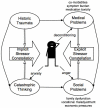Pain and stress in a systems perspective: reciprocal neural, endocrine, and immune interactions
- PMID: 18088561
- PMCID: PMC2278005
- DOI: 10.1016/j.jpain.2007.09.006
Pain and stress in a systems perspective: reciprocal neural, endocrine, and immune interactions
Abstract
This paper advances a psychophysiological systems view of pain in which physical injury, or wounding, generates a complex stress response that extends beyond the nervous system and contributes to the experience of pain. Through a common chemical language comprising neurotransmitters, peptides, endocannabinoids, cytokines, and hormones, an ensemble of interdependent nervous, endocrine, and immune processes operates in concert to cope with the injury. These processes act as a single agent and comprise a supersystem. Acute pain in its multiple dimensions, and the related symptoms that commonly occur with it, are products of the supersystem. Chronic pain can develop as a result of unusual stress. Social stressors can compound the stress resulting from a wound or act alone to dysregulate the supersystem. When the supersystem suffers dysregulation, health, function, and sense of well-being suffer. Some chronic pain conditions are the product of supersystem dysregulation. Individuals vary and are vulnerable to dysregulation and dysfunction in particular organ systems due to the unique interactions of genetic, epigenetic and environmental factors, as well as the past experiences that characterize each person.
Perspective: Acute tissue injury activates an ensemble of interdependent nervous, endocrine, and immune processes that operate in concert and comprise a supersystem. Some chronic pain conditions result from supersystem dysregulation. Individuals vary and are vulnerable to dysregulation due to the unique interactions of genetic, epigenetic, and environmental factors and past experiences that characterize each person. This perspective can potentially assist clinicians in assessing and managing chronic pain patients.
Figures



References
-
- Andersson J. The inflammatory reflex--introduction. J Intern Med. 2005;257:122–5. - PubMed
-
- Anisman H, Merali Z. Cytokines, stress and depressive illness: brain-immune interactions. Ann Med. 2003;35:2–11. - PubMed
-
- Apkarian AV, Bushnell MC, Treede RD, Zubieta JK. Human brain mechanisms of pain perception and regulation in health and disease. Eur J Pain. 2005;9:463–84. - PubMed
-
- Arjomand J, Cole S, Evans CJ. Novel orphanin FQ/nociceptin transcripts are expressed in human immune cells. J Neuroimmunol. 2002;130:100–8. - PubMed
Publication types
MeSH terms
Grants and funding
LinkOut - more resources
Full Text Sources
Other Literature Sources
Medical
Miscellaneous

